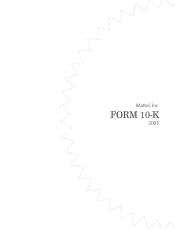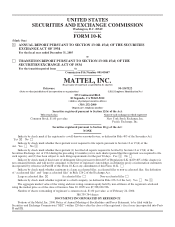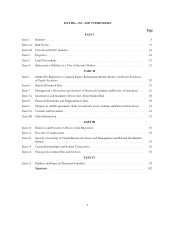Mattel 2005 Annual Report Download - page 16
Download and view the complete annual report
Please find page 16 of the 2005 Mattel annual report below. You can navigate through the pages in the report by either clicking on the pages listed below, or by using the keyword search tool below to find specific information within the annual report.Additionally, independent toy designers and developers bring concepts and products to Mattel and are
generally paid a royalty on the net selling price of products licensed to Mattel. These independent toy designers
may also create different products for other toy companies.
Advertising and Marketing
Mattel supports its product lines with extensive advertising and consumer promotions. Advertising takes
place at varying levels throughout the year and peaks during the traditional holiday season. Advertising includes
television and radio commercials, and magazine and newspaper advertisements. Promotions include in-store
displays, sweepstakes, merchandising materials and major events focusing on products and tie-ins with various
consumer products companies.
During 2005, 2004 and 2003, Mattel incurred $629.1 million (12.1% of net sales), $643.0 million (12.6% of
net sales) and $636.1 million (12.8% of net sales), respectively, on advertising and promotion.
Sales
Mattel’s products are sold throughout the world. Products within the Domestic segment are sold directly to
retailers, including discount and free-standing toy stores, chain stores, department stores, other retail outlets and,
to a limited extent, wholesalers by Mattel Girls & Boys Brands US and Fisher-Price Brands US. Mattel also
operates several small retail outlets, generally near or at its corporate headquarters and distribution centers as a
service to its employees and as an outlet for its products. American Girl Brands products are sold directly to
consumers and its children’s publications are also sold to certain retailers. Mattel has two retail stores, American
Girl Place®in Chicago, Illinois and New York, New York, each of which features children’s products from the
American Girl Brands segment. In 2006, the third American Girl Place®retail store will open in Los Angeles,
California. American Girl Brands also has a retail outlet in Oshkosh, Wisconsin that serves as an outlet for excess
product. Products within the International segment are sold directly to retailers and wholesalers in Canada and
most European, Asian and Latin American countries, and through agents and distributors in those countries
where Mattel has no direct presence. Mattel also has retail outlets in Latin America and Europe as an outlet for
its products. Additionally, Mattel sells certain of its products online through its website.
During 2005, Mattel’s three largest customers (Wal-Mart at $1.0 billion, Toys “R” Us at $0.8 billion and
Target at $0.5 billion) accounted for approximately 45% of worldwide consolidated net sales in the aggregate.
Within countries in the International segment, there is also a concentration of sales to certain large customers that
do not operate in the US. The customers and the degree of concentration vary depending upon the region or
nation. See Item 1A “Risk Factors—Factors That May Affect Future Results” and Item 8 “Financial Statements
and Supplementary Data—Note 11 to the Consolidated Financial Statements.”
Licenses and Distribution Agreements
Mattel has license agreements with third parties that permit Mattel to utilize the trademark, characters or
inventions of the licensor in products that Mattel sells. A number of these licenses relate to product lines that are
significant to Mattel’s business and operations. An important licensor is Warner Bros. Consumer Products, which
has granted Mattel the master toy license for Batman™, Superman™ and Justice League™, as well as the
Harry Potter™ book and movie property, for use on Mattel’s products. Mattel has also entered into license
agreements with, among others: Disney Enterprises, Inc., relating to Disney characters such as Winnie the Pooh
and the Disney Princesses, the new Pixar movie, CARS, scheduled to be released in 2006, and all Disney films
and television properties for use in Mattel’s DVD board games, such as Scene It?™, sold in North America;
Sesame Workshop relating to its Sesame Street®properties; Viacom International, Inc. relating to its
Nickelodeon®properties including SpongeBob SquarePants™and Dora the Explorer™; and Nihon Ad Systems
Inc. for the master toy license to the Yu-Gi-Oh!™property worldwide, excluding Asia.
7
























